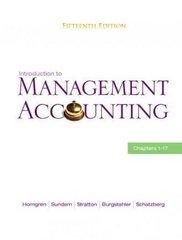Question
Christopher's Custom Cabinet Company uses a job order cost system with overhead applied as a percentage of direct labor costs. Inventory balances at the beginning
Christopher's Custom Cabinet Company uses a job order cost system with overhead applied as a percentage of direct labor costs. Inventory balances at the beginning of 2018 follow:
Raw Materials Inventory$16,300Work in Process Inventory5,100Finished Goods Inventory21,600
The following transactions occurred during January:
(a)Purchased materials on account for $27,800.
(b)Issued materials to production totaling $21,700, 90 percent of which was traced to specific jobs and the remainder of which was treated as indirect materials.
(c)Payroll costs totaling $17,800 were recorded as follows:
$11,000 for assembly workers
2,900 for factory supervision
1,700 for administrative personnel
2,200 for sales commissions
(d)Recorded depreciation: $5,400 for factory machines, $600 for the copier used in the administrative office.
(e)Recorded $1,000 of expired insurance. Forty percent was insurance on the manufacturing facility, with the remainder classified as an administrative expense.
(f)Paid $5,900 in other factory costs in cash.
(g)Applied manufacturing overhead at a rate of 200 percent of direct labor cost.
(h)Completed all jobs but one; the job cost sheet for the uncompleted job shows $2,300 for direct materials, $2,100 for direct labor, and $4,200 for applied overhead.
(i)Sold jobs costing $50,900. The revenue earned on these jobs was $66,170.
Required:
1.Set up T-accounts, record the beginning balances, post the January transactions, and compute the final balance for the following accounts:
- Raw Materials Inventory.
- Work in Process Inventory.
- Finished Goods Inventory.
- Cost of Goods Sold.
- Manufacturing Overhead.
- Selling, General, and Administrative Expenses.
- Sales Revenue.
2.Determine how much gross profit the company would report during the month of Januarybeforeany adjustment is made for the overhead balance.
3.Determine the amount of over- or underapplied overhead.
4.Compute adjusted gross profit assuming that any over- or underapplied overhead balance is adjusted directly to Cost of Goods Sold.

Step by Step Solution
There are 3 Steps involved in it
Step: 1

Get Instant Access to Expert-Tailored Solutions
See step-by-step solutions with expert insights and AI powered tools for academic success
Step: 2

Step: 3

Ace Your Homework with AI
Get the answers you need in no time with our AI-driven, step-by-step assistance
Get Started


